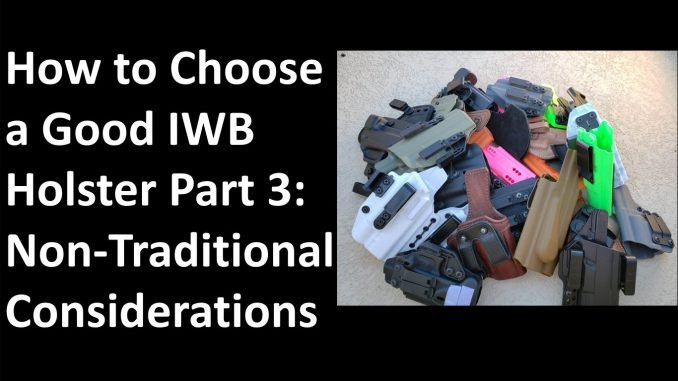
There are a few other considerations to make outside of Tom Givens’ big four. While every holster needs to be Comfortable, Concealable, Secure, and Fast, there are more minor options that aren’t as steadfast, but can make a world of difference for the user. If you haven’t read Part 1 or Part 2 of this series, check those out as well.
IWB Holster Selection – Closed vs Open Muzzle
This is one option that is pure user preference. Most people don’t give a second thought to what style of muzzle is on their holster, but the differences can be shocking once you know what to look for.
Closed Muzzles
Closed muzzles aren’t quite as common in kydex holsters as they are in leather, but still maintain a strong foothold. These are pretty self explanatory; material extends slightly past the muzzle, coming to a close, with a somewhat rounded shape. Often times closed muzzle holsters are more comfortable than their open counterparts, which really adds up after extended periods of wear. Another advantage is additional protection for the wearer from the hot muzzle of their gun, a potential godsend after long courses of fire.
A major, though rarely needed, shortcoming is the inability to easily remove debris from the holster. This can be in the form of brass making its way down into the holster, or any other obstruction. To remedy this, users typically need to completely remove and shake out the holster, which isn’t always a realistic option.
Open Muzzles
An open muzzle can allow users to swap similar model pistols with varying barrel lengths, such as the Glock 26 to Glock 34, while maintaining proper fit with the holster. Some closed muzzle designs allow for this as well, but the wearer will have to hedge their bets with the longer models from the outset. Exposed slide and barrel can get a little toasty after a few magazines, but this is largely only an issue in training, not so much in a defensive encounter. Additionally, open muzzles can allow debris to fall through the holster, such as spent brass. This benefit has come in handy on more than one occasion for me during class and practice.
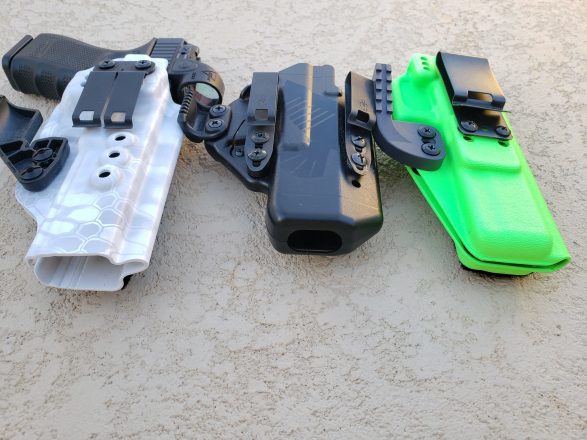
One shortcoming of open muzzles is that they are usually more squared off, in the shape of the slide and dustcover. This can hamper comfort, especially when seated for long periods of time. Users can also be exposed to the hot muzzle of their gun, depending on how close it is to the end of the holster. Though smoother finishing, and the use of a good concealment wedge can help mitigate some of these comfort issues.
Partially Closed Muzzles
A comfortable middle ground between the two main types are partially closed muzzle holsters. These holsters feature rounded muzzles, improving comfort like their closed brethren, but leave a small opening at the bottom for drainage like an open muzzle. Some, like the PHLster Pro Series, have enough of an opening for use with longer slides, such as with Glock pistols. Partially closed muzzle holsters are my preference, reducing fatigue over long durations of wear, while also reducing the likelihood of an obstruction in the holster.
IWB Holster Selection One Handed Holstering
In a perfect world, we’ll always have the opportunity to perform a textbook holstering process. Efficiently clearing concealment with our support hand, reluctantly reholstering with our dominant hand. Unfortunately, we do not live in a perfect world.
There are several factors that may result in us having to holster our firearm with just one hand. This could be an injury from a fight, wrangling family or pets, or a variety of other possibilities. With this in mind, we need to be able to put our gun away with one hand. Not only this, but we need to have the ability to do this with either hand, as we cannot predict which hand will be the one available to us. How do we ensure our holster can accomplish this? There are a few easy steps.
Remains Open When Empty
First and foremost, our holster must stay open once the gun is removed from it. This means it needs to be completely rigid, like a kydex holster, or feature a reinforced mouth like on the Milt Sparks Summer Special. An open holster mouth ensures we can easily press the gun into the holster, with no worries of material catching on the trigger or other control surfaces.
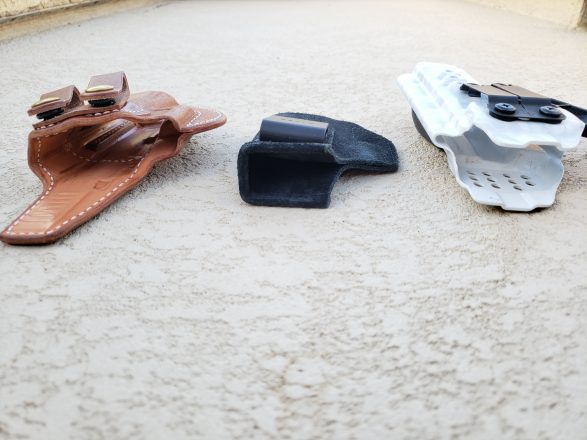
Any holster which collapses upon itself when empty needs to be removed from the waistband before reinserting your gun, as soft holsters are often a major culprit in unintentional discharges.
Universally Accessible
Next, the holster must be accessible with either hand. While no holster will be equally accessible with both hands, we can improve our ability to reach it by changing the holster’s position on our body. Appendix carry is hands-down the easiest way to do this, being nearly equidistant from either hand at all times, and well within our vision to aid the less familiar hand if necessary. Strong side will be the next easiest place to reach with our support hand, though there can be some concealment challenges here.
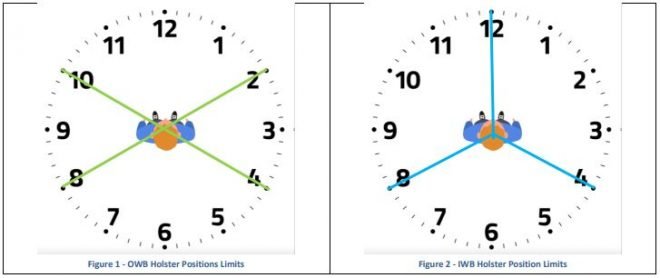
Behind the hip and small of the back can be difficult to impossible to reach with your offside depending on your level of flexibility, making them a challenge in the event you need to holster your gun with the non-dominant hand. This isn’t a condemnation of those other positions, but something to be aware of when deciding where to carry your pistol.
IWB Holster Selection – Ambidextrous Designs
We may not always have the luxury of a usable dominant hand. Injuries happen–from car crashes, slips and falls, and plenty of other normal accidents can take our strong side out of the picture. Have you considered what you’d do if that were to happen to you? Do you have the equipment, let alone the skills, necessary to carry and shoot with your non-dominant hand? Carrying in our normal holster and drawing with the offside is an option, but it’s certainly more cumbersome and time consuming than a support side holster. Buying an exact replica of your preferred holster is costly, and some manufacturers don’t even support wrong-handed shooters for us prepared righties.
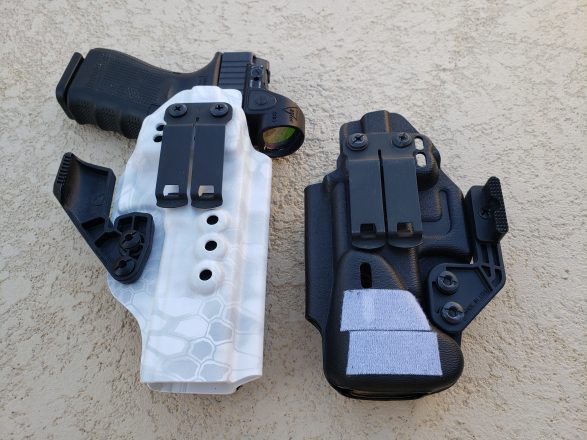
Luckily a few quality companies have started making fully ambidextrous holsters, allowing us to save some coin while staying strapped. I personally own three ambi holsters: the Raven Concealment Eidolon, PHLster’s Pro Series, and the new Lexington from KSG Armory. Each are fantastic options, having gone through multiple classes with me, and cover a wide variety of pistols.
That’s not to say they’re the be-all-end-all of ambidextrous holster design, but they’re certainly my preference to date. Even if you’re not injury prone like some of us, a little bit of insurance goes a long way. I’ve written more about this subject, and weak hand practice with an article titled “Training Weak Hand Shooting Is Important” which can be found on Ammoland.com for those looking for more information.
IWB Holster Selection – Color
Color is something that most people brush off as simple customization for personal taste. However, there can be some tangible benefits when selecting the right color. As an advocate of looking your gun into the holster, lighter colors are desirable for me. These brighter hues can help reflect light into the empty holster, making it easier for me to see any obstructions that may need to be removed. Light earth tones, bright green, hot pink, and plain white are just a few examples I have for bold colors in my own concealment holsters.
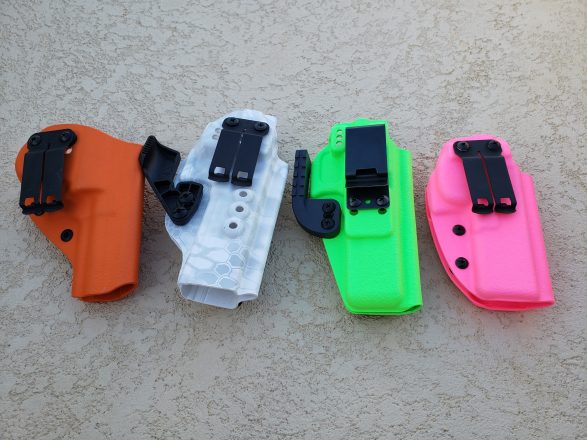
On the flip side, a more muted color can also be beneficial. While we like to say that we always have perfect concealment, that isn’t always the case. Sometimes a sudden strong wind blows our cover garment up, exposing the gun. Some users stretch too far, trying to reach the top shelf at the grocery store. Maybe you carry behind the hip, and bend over to pick something up, lifting your shirt just a little too high.
A more natural tone, like tan or brown, to try and match our skin can buy us a little benefit of the doubt in situations like this, whereas something like Safety Orange may result in greater scrutiny. When paired with a dark undershirt, the ability for others to visually detect our gun is reduced even further.
IWB Holster Selection Parting Thoughts
This wraps up our three part series on choosing a good IWB holster. Hopefully the tips here will help you in your selection as a conceal carrier, and saves you a few bucks. While these last few considerations aren’t as critical as the first four, they can make a massive difference for safety and quality of life. Has your preferred holster met the mark here, or will you be shopping for a replacement soon?
Support My Work
If you made it this far, thanks for reading! Writing isn’t my full-time profession, and nearly everything I do comes out of my own pocket. Between ammunition, tuition, range fees and more, expenses add up fast. If you like what I have to offer, consider making a donation to my Patreon.
Every bit helps bring more work like this to you, and contributes to shortened timelines or more in-depth work on my part. You’ll also have more direct access to me, offering suggestions for future projects, looking behind the scenes, and getting early access to some content. You can find my Patreon >>HERE<<



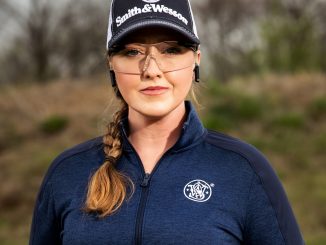
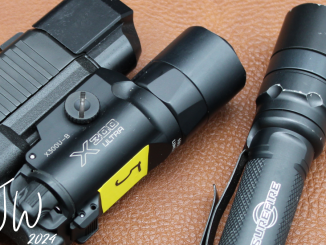
Be the first to comment